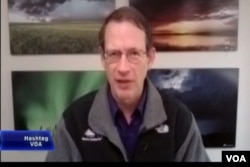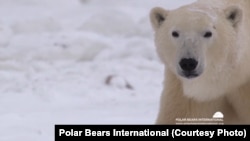A series of weather disasters has shaken the world in recent weeks, with deadly floods in the United States and Britain adding to ongoing droughts in Brazil, South Africa and India.
Global warming is partly to blame because it heats up the world's oceans and sends evaporated water into the atmosphere, where it generates more heat, says Jeff Masters, director of meteorology at U.S. online news service Weather Underground.
"Now with a warmer atmosphere, you have got more energy to power bigger storms," Masters said on this week's Hashtag VOA TV program, in which he appeared via Skype. "Rainstorms will get worse, and when you have drought in a particular area, it can be more intense because the underlying temperatures are higher."
Double impact
Climate change has been raising the planet's temperatures for years. But in 2015, that trend coincided with the start of an unusually strong El Niño, a natural, periodic warming of the eastern Pacific Ocean that can last a year or two.
Some climate observers say the concurrence of global warming and El Niño may have caused temperatures at the North Pole to rise briefly above freezing in December, something Weather Underground says has happened only three times since 1948.
Climate change commentator Robert Fanney, author of U.S. blog robertscribbler, told Hashtag VOA the Arctic heatwave has been
melting sea ice and creating a "feedback" effect.
"The loss of sea ice turns a white reflective surface to a dark heat-absorbing surface [i.e. water]," Fanney said. "So during the summertime, the Arctic Ocean is sucking up a lot more heat from the solar rays, and over time it re-radiates that heat over the fall and into the winter. And that is a really big, new impact that we are seeing."
Masters says Arctic sea ice loss due to human-caused global warming also may have caused the Northern Hemisphere jet stream — a narrow band of air currents — to undergo an "unusual contortion."
"That is where the jet stream makes these giant loops, and underneath one of these giant loops that formed in late December and early January, a lot of warm air surged northwards, reaching all the way to the North Pole," Masters said.
Wildlife threatened
The Arctic's polar bears depend on its shrinking ice surface to live, hunt and breed.
And their numbers are dropping, according to Polar Bears International, a U.S. and Canadian nonprofit group dedicated to conserving the animals.
The group's chief scientist Steven Amstrup, appearing on Hashtag VOA via Skype, said he expects more of the animals to disappear even if the international community can limit global warming to 2 degrees Celsius above pre-industrial levels, as agreed to at last month's Paris climate conference.
"The impacts [from a 2° C warming] would be significant, and we would lose polar bears over much of their current range," Amstrup said. "But this is about a lot more than polar bears. People say, 'Well, polar bears live way up north and why should I care?' They really are harbingers of what is coming to the rest of us."
The climate observers say 2016 could bring more losses to human habitats from cyclones, floods and droughts as global warming and El Niño continue to interact with each other in the coming months.










